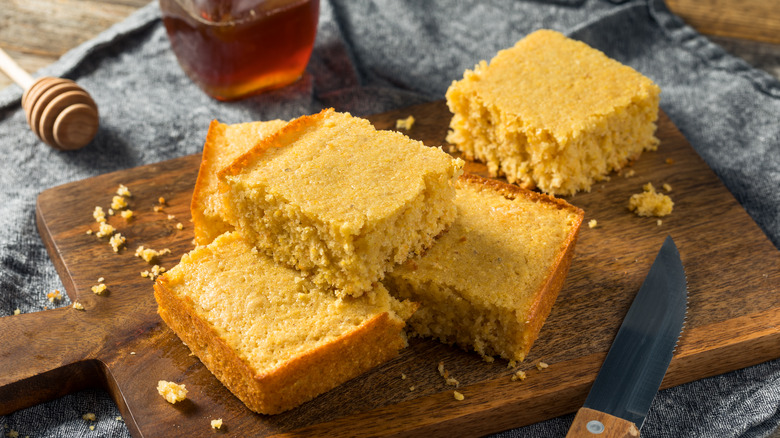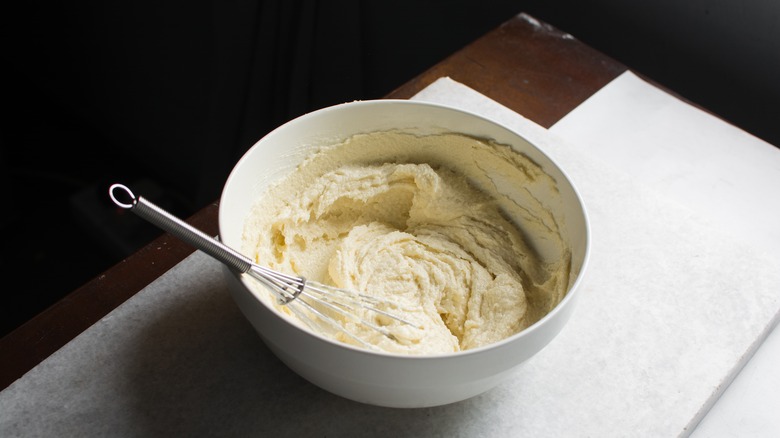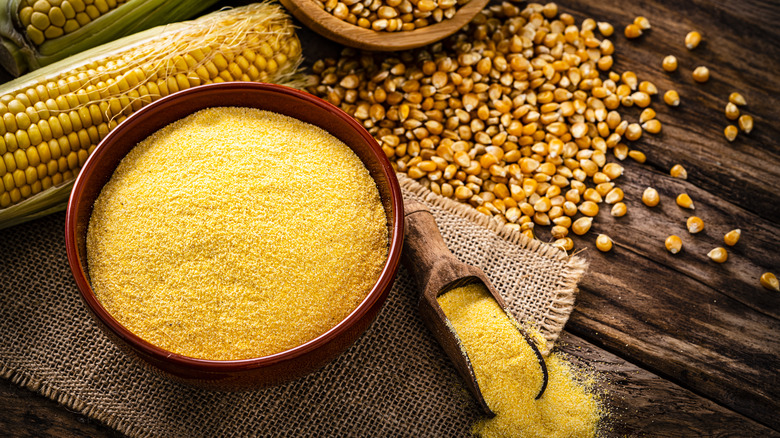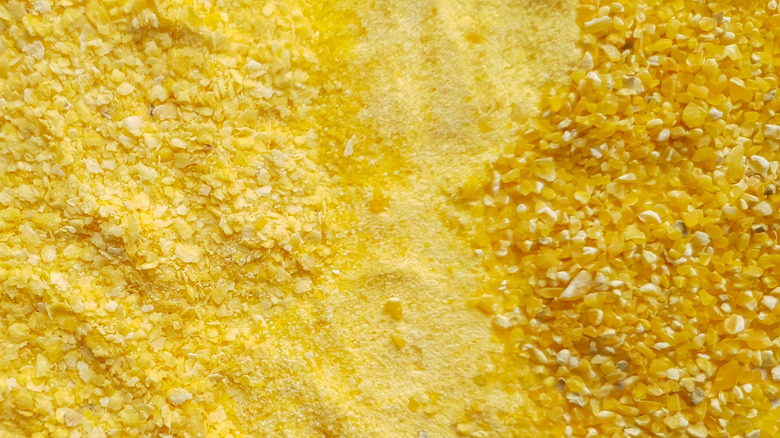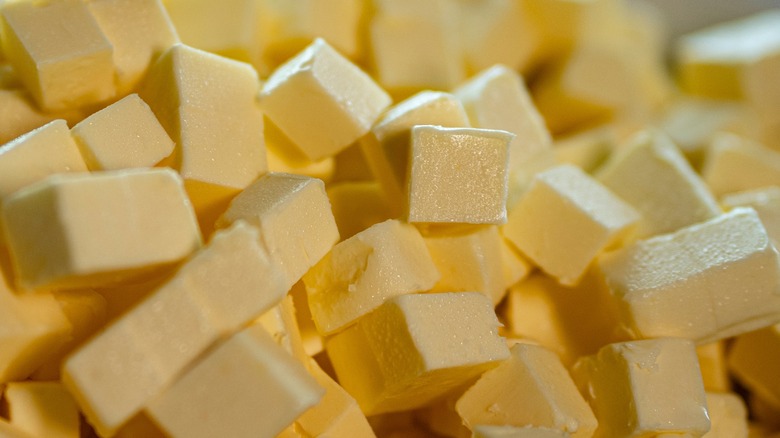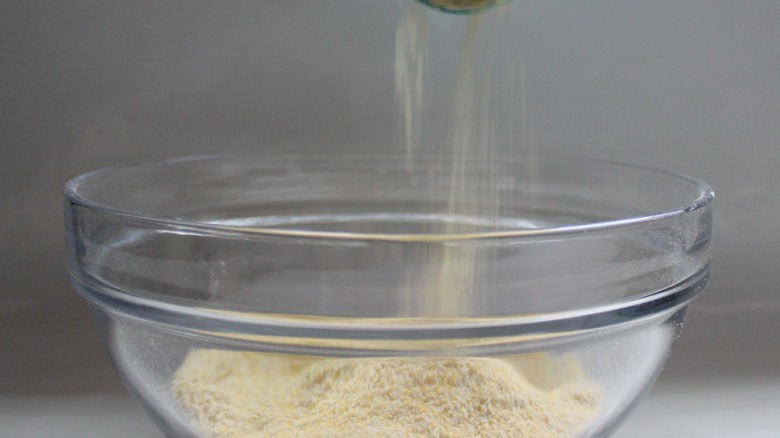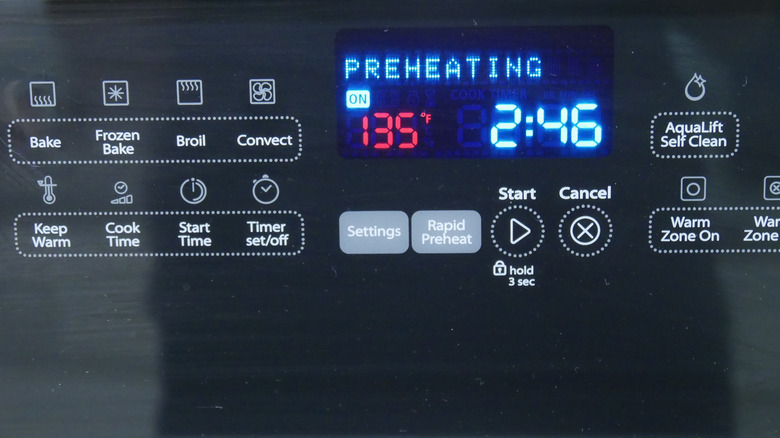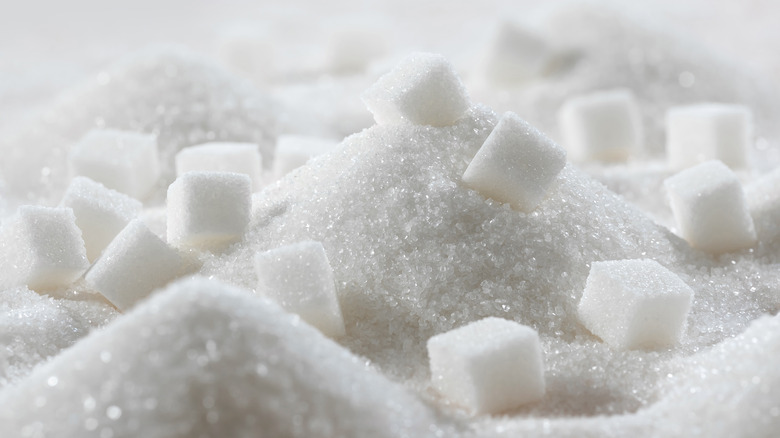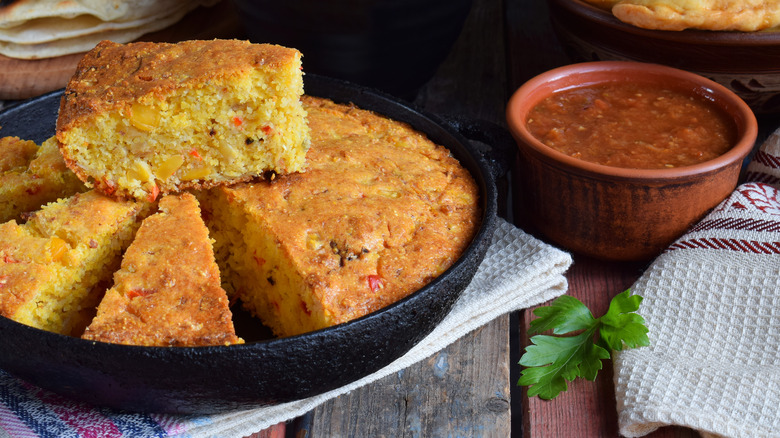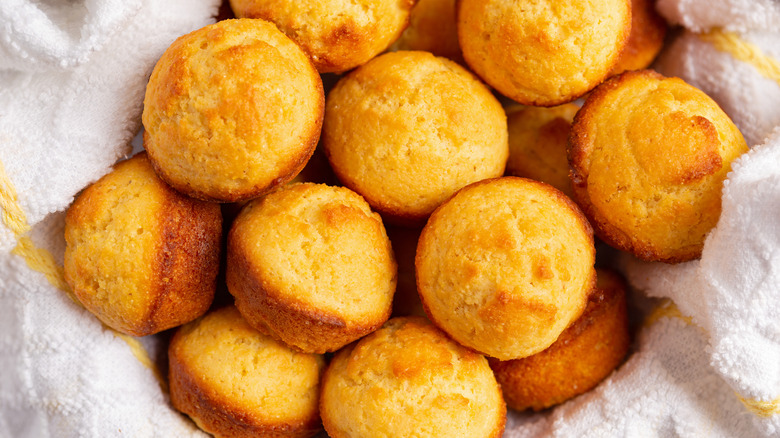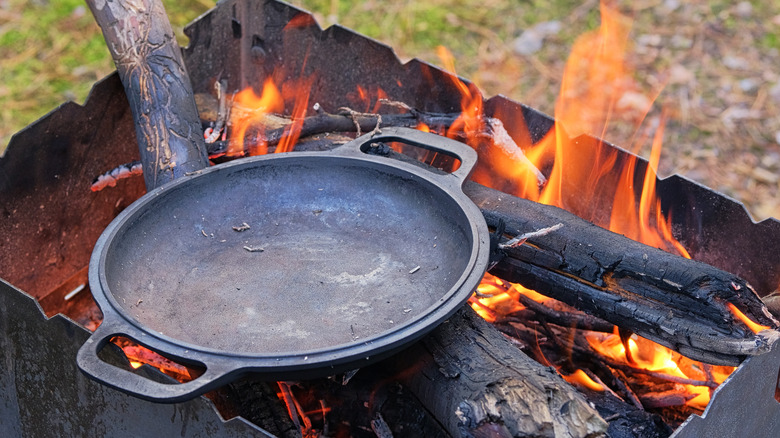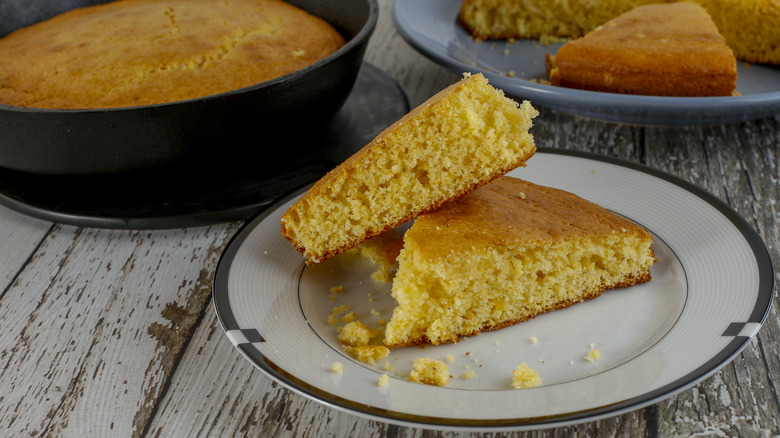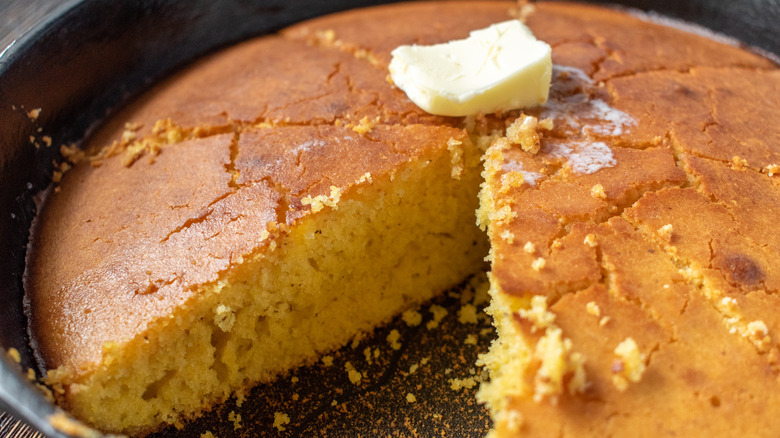12 Mistakes Everyone Makes When Trying To Master Cornbread
Cornbread is one of those rare staple dishes that many people are familiar with across the U.S. It's comfort food that is versatile, with few ingredients simply combined to create a savory bread with a distinct flavor and texture. Cornbread is ubiquitous on the Southern table and has crawled up the coast to New York. It's traditionally served with barbecue, crumbled into a chilly glass of buttermilk, or with a simple pat of butter melting over the top.
If you've tried to recreate either style of these golden beauties and failed, you may be making some common mistakes. The simplicity of the ingredients can mask the potential for baking disaster, and not every baker has the innate chops or the traditional roots to pull off a perfect cast iron skillet of cornbread. Fortunately, with time and (delicious) dedicated practice, it's possible to bake the cornbread of your dreams. If you're making one of these cornbread-baking mistakes, here's how to fix them.
Overmixing the batter
Baking is as much a science as it is an art, and nowhere is this more evident than in the very first stage of mixing the batter. If you are habitually flailing the whisk through your ingredients until they cry out for mercy, chances are good you routinely produce tough, dry cornbread.
In your zeal to thoroughly combine wet and dry ingredients, the extra agitation develops the gluten in any flour you use, creating a tough, dense, chewy bread. It might also end up being gummy or crumbly, depending on how long you bake it. Even if you aren't using flour (as many southern cornbreads don't), the extra air you've whipped into the batter will do one of two things: collapse in the oven or create a cornbread that's overly dry.
The solution is simple. When you combine your wet and dry ingredients, mix them only until there are no visible streaks of dry ingredients. Your batter may seem lumpy, and you may be tempted to whip it a couple more times. Don't. Stop just when the batter comes together, and back away from the bowl. It will all be fine.
Using old or stale cornmeal
In case you were wondering, no, that bag of cornmeal that has been sitting in the back of your cupboard for two years, open and with just a tablespoon or 2 removed, is no good for cornbread. Stale cornmeal tastes exactly as you think it might: a little like dust, with no hint of corn or any other type of flavor.
For best results, use fresh cornmeal. This provides a better flavor and texture, with the true sweet essence of corn shining through. If you don't think you'll use an entire bag of cornmeal, you can store it for future use by placing it in an airtight container and keeping it in a dark, cool place. The back of your cupboard is good, but your freezer is best for long-term storage. If you have a food vacuum sealer, that's even better.
To avoid storing cornmeal in the first place, you can use it immediately, baking up several bashes of cornbread and freezing that. You can also buy cornmeal in bulk. This option is often more cost-effective, and the product is as good (if not better) than what's on the grocery store shelves.
Using the wrong grind of cornmeal
Most people don't realize that cornmeal is available in a variety of textures. Each of these comes from the same foundational product — corn — but the grind of the cornmeal makes all the difference. From fine to stone ground, you have options, and your choice affects your cornbread. Fine cornmeal or cornmeal flour is used for breading food for frying or as a thickener for sauces and gravies. With its large and obvious grains, the coarse grind is best known as polenta or grits. It takes longer to cook and is more substantial.
You'll want either a medium grind or a stone-ground texture for everyday cornbread. Medium cornmeal has more texture than its powdery counterparts and has a noticeable corn flavor and graininess. Stone-ground cornmeal goes even further and is more rustic — the grains are less consistent in size. Some Southern bakers swear that anything other than stone ground is unacceptable, but most will utilize medium grinds (or a mixture of grinds) in a pinch.
If you want a slightly more refined cornbread experience, reach for fine cornmeal. It produces a lighter, cake-like texture that is smoother and more consistent. But if you bring that to a southern picnic, just be ready to be kicked out of the family.
Neglecting the importance of fat
Repeat this mantra to yourself anytime you enter the kitchen: Fat equals flavor. When it comes to baking, fat doesn't only add flavor (although it can bring your boxed cornbread to life). It also keeps your cornbread moist and activates your leavening agents to give your cornbread a lovely, lofty rise.
Fat coats each particle of cornmeal and flour and can protect against overdeveloping gluten. If you are prone to overmixing (the very first mistake), your fat can save the texture of your cornbread. This same coating helps provide structure so that your bread doesn't collapse.
The fat you choose is largely a matter of preference (although some cornbread recipes get very specific and don't allow for swaps). Melted butter, buttermilk, full-fat milk, yogurt, sour cream, and bacon fat: If it is considered fat, it has a place in cornbread. Buttermilk is a traditional ingredient that some modern bakers aren't familiar with. Instead of buying a quart of buttermilk to get the quarter cup you need, add 1 tablespoon of white vinegar to a cup of regular milk and let sit. The vinegar sours the milk and creates a tangy, thicker texture that mimics the flavor of regular buttermilk.
Using improper measuring techniques
Baking intimidates many cooks who are used to throwing a pinch of this and a dash of that into a pan and getting delicious results. That type of measuring system can backfire dramatically when it comes to baking. There is a delicate chemical balance when baking, a balance that requires proper and accurate measuring.
There are two ways to ensure your measurements are accurate. The first is to use a digital kitchen scale to weigh your ingredients. Consider that a pound of rocks and a pound of feathers weigh the same, but the volume of those two things are quite different. The same goes for flour. Flours have different volumes, and weighing them for the most accurate result is best.
If you don't have a digital scale or are concerned about finding recipes that use weight measurements, you must use the proper technique when measuring your flour and cornmeal. Dipping a measuring scoop into the flour or cornmeal can pack it in, resulting in a dry cornbread. To measure properly, first, use a spoon to stir your flour and cornmeal. Scoop the spoon into your flour and add it to your measuring cup. Do this until the measuring cup is rounded, then level it with a knife. Repeat with the cornmeal. And when it comes to wet ingredients, take the same care with measurements. Eggs vary in weight — the most common size for baking is large, but use whatever size your recipe calls for.
Skipping the preheating step
Preheating the oven is a step that even experienced bakers sometimes neglect. But a little thing like putting your cornbread in a chilly oven can ruin it. Preheating the oven is one of those unsung baking heroes, most importantly because it ensures an even cooking temperature. Most ovens have hot and cold spots, but preheating helps to get the temperature as even as possible with your particular oven.
In addition, preheating is crucial for any baked goods that use leavening ingredients like baking powder or baking soda. All these ingredients start acting as soon as they become wet or come into contact with acid, so it is important to take advantage of that action with a properly heated oven. This gives them the best rise possible.
Finally, preheating the oven properly means your cornbread will achieve its lovely golden glow. A preheated oven ensures even baking inside and out and produces a beautifully finished outward appearance. It's best to start the preheating process before measuring your ingredients. Give your oven a solid 10 minutes to heat up, or follow your manufacturer's instructions to determine just how long it should take to reach the desired temperature.
Adding too much sugar
The North and the South have plenty of things to argue about, and cornbread is no different. Serve sweet cornbread to a Southerner and be prepared to be met with a look of such disdain that recovery seems impossible. But Northerners enjoy a little bit of sweetness in their savory bread.
Even so, adding too much sugar turns a savory side dish into a sickly sweet cake-like confection. If your goal is an authentic cornbread that everyone can enjoy, a scant tablespoon of sugar is likely enough to bring out the beautiful, natural sweetness of the cornmeal. The idea here is to strike a balance between the savory elements (including any add-ins) and the subtle sweetness you add.
Of course, if you are from the south, any amount of sugar is too much. In that case, you want a sugar-free traditional savory cornbread, with no sugar allowed. If you are serving guests from both sides of the Mason-Dixon line, achieve detente by serving your no-sugar cornbread with whipped honey butter.
Not experimenting with add-ins
While there is always a place for a traditional, plain cornbread all on its own, experimenting with add-ins brings a bit of variation to what could be considered by some a boring accompaniment to the meal. Add-ins can create a different flavor profile or mix up the texture to bring this side dish front and center.
Whether you are upgrading a boxed cornbread or just trying something new, don't be afraid to take some risks. Add-ins like cheese, jalapeños, bacon, or herbs bring something special to the table — but don't stop there. Pickles, caramelized onions, sundried tomatoes, and mashed sweet potato or pumpkin are unusual additions that spice up plain cornbread.
More uncommon additions include things like chopped nuts, green chilis, roasted garlic, coconut, and kimchi. Use a light touch when it comes to adding strong flavors. You want the corn flavor to remain the strongest note, with support from whatever other ingredients you try.
Ignoring the resting time
Cornbread is a unique baked good that requires time to collect its thoughts before it hits the oven. The baking powder and baking soda in cornbread are activated by liquid. When dry and wet ingredients combine, this activation begins, but it takes time. If you place the batter directly into the oven after it's mixed, the heat can suppress this bubbling action, resulting in a flat cornbread. Additionally, cornmeal requires a few minutes to hydrate. Unlike flour, which quickly absorbs any liquid, cornmeal needs some time to absorb the liquid ingredients.
As with most things, balance is key. Cornbread batter does require resting time, but not too much. Letting your batter sit for too long before baking means that the leavening agents will rise, peak, and begin to fall just as you place it in the oven. For the best results, rest your batter for about 10 minutes before baking. This gives you some time to preheat the pan in which you'll be baking cornbread, too. The batter can rest for up to 20 minutes, but much beyond that, and it's time to add a little more liquid and make cornmeal pancakes.
It's also possible to soak your cornmeal in buttermilk overnight. The acid in the buttermilk tenderizes the cornmeal and allows the cornmeal to fully hydrate. After soaking overnight, let your cornmeal warm slightly, then proceed with your recipe.
Not preheating the skillet or pan
Preheating your baking vessel before pouring in the batter has the same effects as preheating the oven. A preheated skillet is more apt to bake your cornbread evenly, but it goes beyond that. Pouring properly-rested cornbread batter into a preheated skillet or pan jumpstarts the Maillard reaction, initiating the browning and caramelization that gives the cornbread a delicious buttery crust. This provides a delightful contrast between the tender crumb of the interior cornbread and the chewier texture of the crust. A preheated skillet or pan shortens the cooking time and makes for cleanup.
To preheat your skillet or pan, use your preheating oven. The best type of skillet for cornbread is cast iron, as it heats evenly and holds heat well, but any oven-safe skillet or pan will work. Place the skillet in the preheating oven, removing it when the preheat cycle is finished (be careful and use oven mitts). Add the fat you've chosen to the skillet and swirl it gently to coat the bottom and sides of the skillet. Carefully pour the rested batter into the skillet and return it to the oven to bake.
Be mindful of the fat you choose to coat the pan. Because the skillet will be hot when you add the fat, you need one with a high smoke point so that it doesn't burn on the hot skillet. The last thing you want is a greasy, burnt-tasting crust. Lard and coconut oil are both good choices.
Over-baking the cornbread
Properly baking cornbread is just as challenging as getting any other baked goods right. Because you cannot see the center of the cornbread, it can be difficult and often confusing to figure out when it's finished. But sometimes, concern over a fully cooked center results in overcooked, dry cornbread. It's especially difficult to gauge doneness when you bake in a cast iron pan.
There are several methods to test for doneness when you can't see the center of your baked goods. The first is the most old-fashioned: Use a toothpick. Insert the toothpick into the center of your cornbread, making sure not to touch it all the way down to the bottom. The cornbread is done when a crumb or two clings to the toothpick. Don't wait until it's spotless and dry. Carry-over cooking occurs as you allow your cornbread to rest after baking; this inevitable extra cooking means your bread will end up overbaked if you wait until the toothpick is dry.
Gluten-free bakers are experts at another, more modern method of testing for doneness: the digital thermometer. Because gluten-free baked goods can hold on to moisture for longer, it's difficult to bake them properly — taking the temperature is the most reliable gauge. A thermometer that reads between 195 F and 200 F is the best gauge of whether or not your cornbread is fully baked. Combine the best of both worlds and test with a toothpick before verifying doneness with a thermometer.
Eating it straight out of the oven
Holding yourself back from diving into your cornbread as it emerges from the oven can be challenging. With its slightly domed, golden brown top and heavenly aroma, it calls to eaters with a buttery voice. But cut into it now and not only will your first taste be disappointing — your leftovers will be even worse.
Briefly resting your cornbread after its trip in the oven improves everything from the flavor to the texture to the eating experience in general. On top of the potential for pain and the diminishment of taste, allowing your cornbread to cool for even five minutes makes it easier to slice and serve. The texture will be less crumbly, making for neater slices that are easier to eat. Give your cornbread 15 to 20 minutes on the counter before serving for the best taste and enjoyment. It will retain its heat, but the flavor and texture will improve substantially during this brief period.

